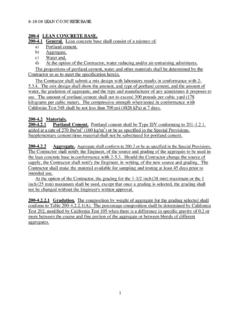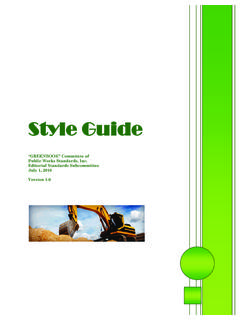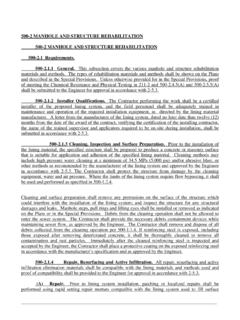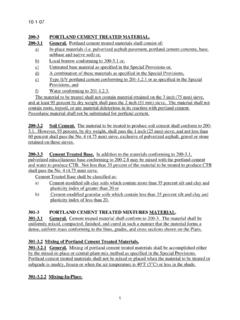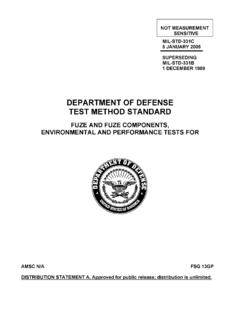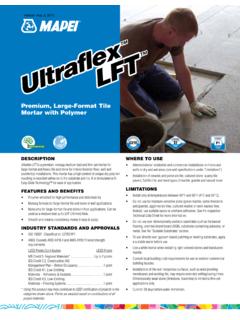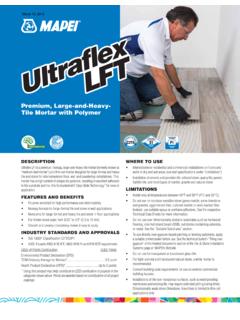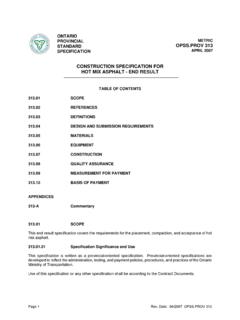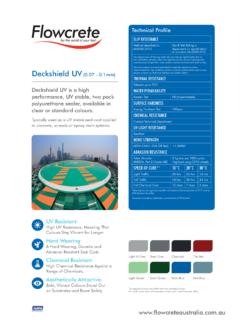Transcription of PART 2 CONSTRUCTION MATERIALS - Public works
1 Change No. 218NS 1 part 2 CONSTRUCTION MATERIALS SECTION 200 ROCK PRODUCTS 200-1 ROCK PRODUCTS General. Rock products are defined as crushed rock, rock dust, gravel, sand, stone for riprap, or any combination thereof. All rock products shall be clean, hard, sound, durable, uniform in quality, and free from any detrimental quantity of soft, friable, thin, elongated or laminated pieces, disintegrated material , organic matter, oil, alkali, or other deleterious substance. Testing. Sieve analysis shall be performed in accordance with California Test 202. Sand equivalent tests shall be performed in accordance with California Test 217. Unless otherwise specified, all percentages referred to in this Section 200 shall be determined by weight. All testing shall use the most current test methods .
2 Statistical Testing. Statistical testing shall conform to the following: Whenever both individual test results and moving average requirements are specified, MATERIALS shall meet both requirements. Individual samples tested prior to the first use of MATERIALS from each source, or prior to the first use of MATERIALS after any changes have been made in material processing procedures, shall conform to the limits specified for moving average. Moving average shall be computed in accordance with 211-5. Crushed Rock and Rock Dust. Crushed rock and rock dust shall be the product of crushing rock or gravel. The portion of the material that is retained on a 3/8-inch ( ) sieve shall contain at least 50 percent of particles having three or more fractured faces. Not over 5 percent shall be pieces that show no such faces resulting from crushing.
3 Of that portion which passes the 3/8-inch ( ) sieve but is retained on the No. 4 ( ) sieve, not more than 10 percent shall be gravel particles. Crushed rock will be designated by normal size and shall conform to the following gradations: TABLE 200-1-2 (A) Percentage Passing Sieves Sieve Size 1 ( ) ( ) ( ) 1-1/2 in( mm) 1 ( ) 3/4 ( ) 1/2 ( ) 3/8 ( ) No. 4 ( ) No. 8 ( ) ASTM C 131 Test Grading 100 90-100 30-60 0-20 - 0-5 - A - 100 90-100 30-60 0-20 0-5 - B - - 100 90-100 20-60 0-15 0-5 B Change No. 218NS 2 TABLE 200-1-2 (A) (Continued) Sieve Size 3/8 ( ) ( ) 3/16 ( ) Rock Dust 1/2 in( mm) 3/8 ( ) 1/4 ( ) No. 4 ( ) No. 8 ( ) No. 16 ( ) No. 30 (600 m) No. 200 (75 m) ASTM C 131 Test Grading 100 90-100 - 30-60 0-10 - - - C - - 100 75-100 0-25 0-5 - 0-2 D - - - 100 40-75 0-10 - 0-2 B - 100 - 90-100 - - 20-60 5-20 - Crushed rock shall meet the following requirements: TABLE (B) Test Test Method No.
4 Requirements in percent Percentage Wear 100 Revolutions 500 Revolutions ASTM C 131 15 Maximum 52 Maximum Screenings. Screenings when used as a cover aggregate for asphalt emulsion chip seals in accordance with , shall be composed of crushed rock and will be designated by the name of the size of screenings and shall conform to the following gradations in Table (A): All screenings in and shall meet the following requirements: TABLE (A) Percentage Passing Sieve Sieve Size Coarse 1/2 x No. 4 ( x ) Medium 3/8 x No. 6 ( x ) Medium Fine 5/16 x No. 8 ( x ) Fine x No. 10 ( x ) 3/4 ( ) 1/2 ( mm) 3/8 ( ) No. 4 ( ) No. 8 ( ) No. 16 ( ) No. 30 (600 m) No. 200 (75 m) 100 90-100 50-80 0-15 0-5 - - 0-2 - 100 90-100 5-30 0-10 0-5 - 0-2 - - 100 30-60 0-15 0-5 0-3 0-2 - - 100 60-85 0-25 0-5 0-3 0-2 TABLE (B) Test Test Method No.
5 Requirements in percent Percentage Wear (100 Revolutions) ASTM C 131 12 Maximum Change No. 218NS 3 Percentage Wear (500 Revolutions) Film Stripping Cleanliness Value California Durability ASTM C 131 California 302 California 227 California 229 35 Maximum 25 Maximum 80 Minimum 52 Minimum Gravel. Gravel shall be composed entirely of particles that have no more than one fractured face. Coarse Aggregate for Portland Cement Concrete. Concrete aggregate shall be composed of gravel, crushed rock, or a blended mixture. All concrete aggregate shall be washed before delivery to the batching plant and shall conform to the following: TABLE (A) Tests Tests Method No. Requirements Cleanness Value Moving Average2 Percentage Ware 100 revolutions 500 revolutions Specific Gravity (Bulk Saturated surface dry) California 227 ASTM C131 or California 211 ASTM C 127 75 Minimum 75 Minimum 15 Maximum 52 Maximum Minimum1 1.
6 Not more than 15 percent by weight shall be particles with a bulk specific gravity below 2. Moving Average calculated in accordance with 211-5; no individual test result used shall be less than 71. Concrete aggregate will be designated by number and shall conform to the following gradations: TABLE (B) Percentage Passing Sieve Sieve Size No. 2 No. 3 No. 4 50 mm (2 in) mm (1-1/2 in) mm (1 in) mm (3/4 in) mm (3/8 in) mm (No. 4) mm (No. 8) 75 m (No. 200) ASTM C 131 Test Grading 100 90-100 5-40 0-15 0-5 - - 0-2 A - 100 90-100 55-85 8-20 0-5 0-5 0-2 B - - - 100 85-100 0-30 0-10 0-2 C Sand. Change No. 218NS 4 General. Sand shall consist of natural or manufactured granular material , or a combination thereof, free of deleterious amounts of organic material , mica, loam, clay, and other substances not suitable for the purpose intended.
7 Sand for Asphalt Concrete. The sand shall conform to the gradation specified for asphalt concrete in Sand for Portland Cement Concrete. Sand for portland cement concrete shall be washed and shall conform to the gradation specified for portland cement concrete in and the following quality requirements: TABLE (A) Tests Test Method No. Requirements in percent Organic Impurities Mortar Strength Relative to Ottawa Sand Sand Equivalent Individual Test Result Average of Tests on 3 Samples Moving Average3 Percent Clay, Silt, Loam ASTM C 40 California 515 California 217 California 515 Satisfactory1 100 Minimum 75 Minimum 70 Minimum 75 Minimum 75 Minimum 3 Maximum Soundness2 California 214 10 Maximum 1. The resultant color of the testing solution shall not be darker than the ASTM C 40 standard. 2.
8 The soundness requirement will be waived, provided that the durability index, Df, is 60 or greater, when determined by California Test 229. 3. Moving Average calculated in accordance with 211-5; no individual test result used shall be less than 70. Sand For Air-Placed Concrete. Sand for air-placed concrete shall be washed and conform to the gradation for portland cement concrete in The amount of deleterious substances shall not exceed the limits prescribed in ASTM C 33. Sand Gradations. The sand shall conform to the following gradations: TABLE (A) Percentage Passing Sieve Sieve Size Asphalt Concrete Portland Cement Concrete Mortar mm (3/8 in) mm ( ) mm ( ) mm ( ) 600 m ( ) 300 m ( ) 150 m ( ) 75 m (No. 200) 100 - 75-100 - - - - 0-81 100 95-100 75-90 55-75 30-50 10-25 2-10 0-5 - 100 95-100 70-95 35-70 5-35 0-10 0-5 1.
9 May be exceeded to permit a maximum of 12 percent, provided the sand equivalent of the asphalt concrete sand is 35 or greater. Change No. 218NS 5 SECTION 211 material TESTS 211-1 COMPACTION TESTS. Laboratory Maximum Density. The following method shall be used for compaction tests unless otherwise specified: Laboratory maximum densities will be performed in accordance with ASTM D 1557. The Engineer may modify ASTM D 1557 at his option to calculate relative compaction based on adjusted maximum density calculated as follows: Da = (100 Dm) / (100 +Wa) Da = Adjusted laboratory maximum wet density. Dm = Maximum wet density per ASTM D 1557. +Wa = Percent change in moisture content from field moisture to laboratory optimum moisture. Use minus when field moisture content is higher than laboratory optimum moisture content.
10 Use plus when field moisture is lower than laboratory optimum moisture content. Field Density. Field density of soil shall be determined by ASTM D 2922 or ASTM D 1556. Relative Compaction. The words Relative Compaction shall mean the ratio of the field dry or wet density to the laboratory dry or adjusted wet density, respectively, expressed as a percentage. 211-2 CHEMICAL RESISTANCE TEST (PICKLE JAR)). This test is used to determine the physical properties of material specimens used in sewers after exposure to chemical solutions. Specimens of composite MATERIALS shall be seal coated on two adjacent edges of their four edges and not coated on the inner or outer surfaces. Specimens of non-composite MATERIALS shall not be seal coated.

